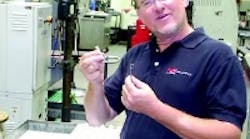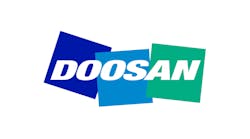Better communications helped Mike Kenney to increase productivity.
MKT INNOVATIONS WAS NEARLY broke and out of business in 2003. Its customers were fleeing offshore and, for the few customers the shop had left, it was not the first-choice supplier.
Mike Kenney, a machinist and entrepreneur with 30 years of experience, saw the company he founded with his wife, Julie, on the verge of closing. To resuscitate the business, Kenney fell back on his past strategic-management training.
He says now that it was desperation that drove him to get everyone who remained in his shop involved in a team effort to implement the strategic training. The shop had dropped nearly 30 percent of its staff from 1999 to 2003, and was left with 50 people. The job reductions helped to focus attention. Kenney introduced a strict lean manufacturing program in the shop that changed the company's entire business culture, and he started to have regular, one-hour weekly meetings with everyone in the shop. In these meetings he shared performance data, including profit and loss reports and production scheduling and order information. His goal was to give everyone the ability to understand what was expected of them and when.
"Every one of our employees is a businessman of sorts in his own household. They all understand profit and loss data because they have to balance their checkbooks at the end of every month," Kenney said. With that in mind, he went to his employees and showed them how productivity gains affect them. For example: he explained to his employees that a 10 percent to 20 percent reduction in labor on a job leads to more profit, and more profit leads to better wages.
Kien Tran, production supervisor at MKT Innovations, confirms how that translated to the shop floor: Annual wage increases at the shop averaged 10 percent over the past three years, compared to 3 percent to 5 percent in previous years, Tran said.
Along with the lean manufacturing and the broad communications initiatives, Kenney changed his shop's manufacturing processes. He moved machinery to make manufacturing cells that could take advantage of one workholding setup for several operations, and he required multitasking from his employees.
"We introduced new machinery, new tooling and new software, and with each one we showed our employees how each new tool could help them to be more productive. We got a team effort going, and reported our progress back to our employees to demonstrate the benefits," Kenney says.
"We are now producing 50 percent to 60 percent more volume than we were in 1999, and with 30 percent fewer employees," he adds.
Kenney says high-pressure coolant systems cut machining cycle times by as much as 50 percent, and provide as much as a 20 percent cost reductions in machining.
Tran confirmed Kenney's estimate on drill life and cycle reduction with the high-pressure coolant system.
He said normal life for a high-speed carbide drill was approximately 500 holes for one job the shop had; adding that, with the high-pressure, through-the-tool coolant system, tool life increased to nearly 3,000 holes even as the cycle time was reduced from 3 min to 30 sec.
Besides its gains in cost reductions and efficiencies, Kenney said MKT has seen gains in quality even as the number of its customers increases.
Kenney's shop had a 99.3 percent part-acceptance-by-customers rate for the 248,069 parts the shop produced by the end of July.
| MKT Innovations Brea, Calif. www.mkti.com Number of employees — 50 2006 sales — $10 million Markets served — Medical, high tech, semi-conductor, |


